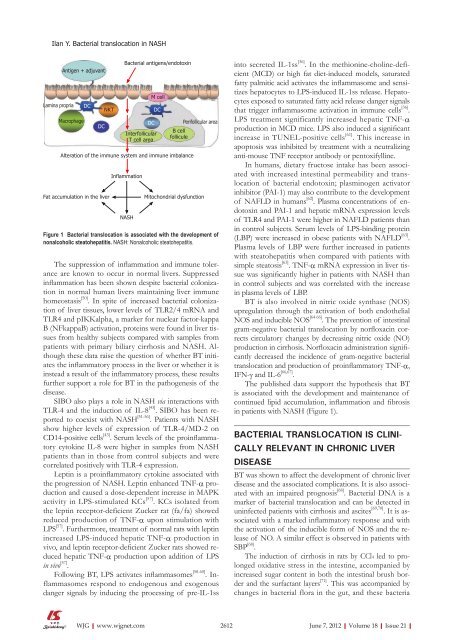Evidence base and patients' perspective - World Journal of ...
Evidence base and patients' perspective - World Journal of ...
Evidence base and patients' perspective - World Journal of ...
You also want an ePaper? Increase the reach of your titles
YUMPU automatically turns print PDFs into web optimized ePapers that Google loves.
Ilan Y. Bacterial translocation in NASH<br />
Lamina propria<br />
Antigen + adjuvant<br />
Macrophage<br />
DC<br />
DC<br />
NKT<br />
The suppression <strong>of</strong> inflammation <strong>and</strong> immune tolerance<br />
are known to occur in normal livers. Suppressed<br />
inflammation has been shown despite bacterial colonization<br />
in normal human livers maintaining liver immune<br />
homeostasis [50] . In spite <strong>of</strong> increased bacterial colonization<br />
<strong>of</strong> liver tissues, lower levels <strong>of</strong> TLR2/4 mRNA <strong>and</strong><br />
TLR4 <strong>and</strong> pIKKalpha, a marker for nuclear factor-kappa<br />
B (NFkappaB) activation, proteins were found in liver tissues<br />
from healthy subjects compared with samples from<br />
patients with primary biliary cirrhosis <strong>and</strong> NASH. Although<br />
these data raise the question <strong>of</strong> whether BT initiates<br />
the inflammatory process in the liver or whether it is<br />
instead a result <strong>of</strong> the inflammatory process, these results<br />
further support a role for BT in the pathogenesis <strong>of</strong> the<br />
disease.<br />
SIBO also plays a role in NASH via interactions with<br />
TLR-4 <strong>and</strong> the induction <strong>of</strong> IL-8 [43] . SIBO has been reported<br />
to coexist with NASH [51-56] . Patients with NASH<br />
show higher levels <strong>of</strong> expression <strong>of</strong> TLR-4/MD-2 on<br />
CD14-positive cells [43] . Serum levels <strong>of</strong> the proinflammatory<br />
cytokine IL-8 were higher in samples from NASH<br />
patients than in those from control subjects <strong>and</strong> were<br />
correlated positively with TLR-4 expression.<br />
Leptin is a proinflammatory cytokine associated with<br />
the progression <strong>of</strong> NASH. Leptin enhanced TNF-α production<br />
<strong>and</strong> caused a dose-dependent increase in MAPK<br />
activity in LPS-stimulated KCs [57] . KCs isolated from<br />
the leptin receptor-deficient Zucker rat (fa/fa) showed<br />
reduced production <strong>of</strong> TNF-α upon stimulation with<br />
LPS [57] . Furthermore, treatment <strong>of</strong> normal rats with leptin<br />
increased LPS-induced hepatic TNF-α production in<br />
vivo, <strong>and</strong> leptin receptor-deficient Zucker rats showed reduced<br />
hepatic TNF-α production upon addition <strong>of</strong> LPS<br />
in vivo [57] .<br />
Following BT, LPS activates inflammasomes [58-60] . Inflammasomes<br />
respond to endogenous <strong>and</strong> exogenous<br />
danger signals by inducing the processing <strong>of</strong> pre-IL-1ss<br />
WJG|www.wjgnet.com<br />
Bacterial antigens/endotoxin<br />
DC<br />
Interfollicular<br />
T cell area<br />
M cell<br />
DC<br />
B cell<br />
follicule<br />
Alteration <strong>of</strong> the immune system <strong>and</strong> immune imbalance<br />
Inflammation<br />
Perifollicular area<br />
Fat accumulation in the liver Mitochondrial dysfunction<br />
NASH<br />
Figure 1 Bacterial translocation is associated with the development <strong>of</strong><br />
nonalcoholic steatohepatitis. NASH: Nonalcoholic steatohepatitis.<br />
into secreted IL-1ss [36] . In the methionine-choline-deficient<br />
(MCD) or high fat diet-induced models, saturated<br />
fatty palmitic acid activates the inflammasome <strong>and</strong> sensitizes<br />
hepatocytes to LPS-induced IL-1ss release. Hepatocytes<br />
exposed to saturated fatty acid release danger signals<br />
that trigger inflammasome activation in immune cells [36] .<br />
LPS treatment significantly increased hepatic TNF-α<br />
production in MCD mice. LPS also induced a significant<br />
increase in TUNEL-positive cells [61] . This increase in<br />
apoptosis was inhibited by treatment with a neutralizing<br />
anti-mouse TNF receptor antibody or pentoxifylline.<br />
In humans, dietary fructose intake has been associated<br />
with increased intestinal permeability <strong>and</strong> translocation<br />
<strong>of</strong> bacterial endotoxin; plasminogen activator<br />
inhibitor (PAI-1) may also contribute to the development<br />
<strong>of</strong> NAFLD in humans [62] . Plasma concentrations <strong>of</strong> endotoxin<br />
<strong>and</strong> PAI-1 <strong>and</strong> hepatic mRNA expression levels<br />
<strong>of</strong> TLR4 <strong>and</strong> PAI-1 were higher in NAFLD patients than<br />
in control subjects. Serum levels <strong>of</strong> LPS-binding protein<br />
(LBP) were increased in obese patients with NAFLD [63] .<br />
Plasma levels <strong>of</strong> LBP were further increased in patients<br />
with steatohepatitis when compared with patients with<br />
simple steatosis [63] . TNF-α mRNA expression in liver tissue<br />
was significantly higher in patients with NASH than<br />
in control subjects <strong>and</strong> was correlated with the increase<br />
in plasma levels <strong>of</strong> LBP.<br />
BT is also involved in nitric oxide synthase (NOS)<br />
upregulation through the activation <strong>of</strong> both endothelial<br />
NOS <strong>and</strong> inducible NOS [64-66] . The prevention <strong>of</strong> intestinal<br />
gram-negative bacterial translocation by norfloxacin corrects<br />
circulatory changes by decreasing nitric oxide (NO)<br />
production in cirrhosis. Norfloxacin administration significantly<br />
decreased the incidence <strong>of</strong> gram-negative bacterial<br />
translocation <strong>and</strong> production <strong>of</strong> proinflammatory TNF-α,<br />
IFN-γ <strong>and</strong> IL-6 [66,67] .<br />
The published data support the hypothesis that BT<br />
is associated with the development <strong>and</strong> maintenance <strong>of</strong><br />
continued lipid accumulation, inflammation <strong>and</strong> fibrosis<br />
in patients with NASH (Figure 1).<br />
BACTERIAL TRANSLOCATION IS CLINI-<br />
CALLY RELEVANT IN CHRONIC LIVER<br />
DISEASE<br />
BT was shown to affect the development <strong>of</strong> chronic liver<br />
disease <strong>and</strong> the associated complications. It is also associated<br />
with an impaired prognosis [68] . Bacterial DNA is a<br />
marker <strong>of</strong> bacterial translocation <strong>and</strong> can be detected in<br />
uninfected patients with cirrhosis <strong>and</strong> ascites [69,70] . It is associated<br />
with a marked inflammatory response <strong>and</strong> with<br />
the activation <strong>of</strong> the inducible form <strong>of</strong> NOS <strong>and</strong> the release<br />
<strong>of</strong> NO. A similar effect is observed in patients with<br />
SBP [68] .<br />
The induction <strong>of</strong> cirrhosis in rats by CCl4 led to prolonged<br />
oxidative stress in the intestine, accompanied by<br />
increased sugar content in both the intestinal brush border<br />
<strong>and</strong> the surfactant layers [71] . This was accompanied by<br />
changes in bacterial flora in the gut, <strong>and</strong> these bacteria<br />
2612 June 7, 2012|Volume 18|Issue 21|

















